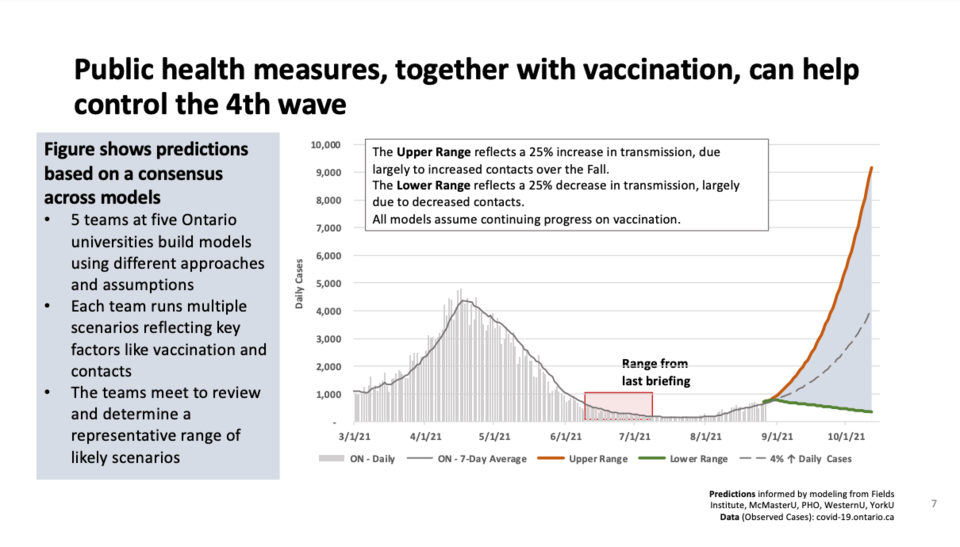The doctors watching the trajectory of COVID-19 in Ontario say some intervention – but not necessarily a lockdown – will be needed during the fourth wave to prevent ICUs from being overwhelmed again.
The Ontario Science Table released fourth wave modelling Sept. 1 via its website and social media. It’s the first time since June the table has published modelling data.
Though the table didn’t make its usual media presentations, some members of the advisory group took to Twitter to explain the best and worst-case scenarios.
At the current trajectory of the fourth wave, the table expects about 500 COVID patients in ICUs by October, and predicts ICUs will be “overwhelmed beyond what we saw in the third wave.”
The delta variant has changed the province’s COVID response already, prompting the Chief Medical Officer of Health, Dr. Kieran Moore, to announce a pause on the roadmap to reopening to hold current restrictions in place until further notice.
A report by Public Health Ontario in July stated previous estimates of vaccine coverage needed to begin lifting public health measures were based on the alpha variant, and should be revised for the delta variant. The province's Roadmap to Reopen was based on alpha variant vaccination rates, and stated Ontario could exit the plan with 75 per cent of the eligible population vaccinated.
Based on delta variant patterns, Public Health Ontario estimated the "critical threshold" for vaccination at 90 per cent of the total population, which is more than 100 per cent of the eligible population.
“Because of the delta variant, and to avoid a lockdown in the fall, vaccination needs to accelerate … and we need to reduce contacts,” stated the science table release.
According to the science table’s last release, the delta variant has a reproductive number between six and eight, meaning every person infected typically passes the virus on to six-to-eight other people. The original strain of SARS-CoV-2 (the virus causing COVID-19) had a reproductive number between two and three.
The risk of hospitalization and intensive care admission after infection is also two-to-three times higher with the delta variant, according to the science table.
Dr. Beate Sander, a member of the science table and co-chair of the modelling consensus table posted a Twitter thread comparing the delta variant to “driving on an icy road.”
“Traveling fast means we need to brake hard at the stop sign ahead of us, travelling slow means … we have more time to react,” tweeted Sander.
In the case of Ontario’s fourth wave, travelling slow means reducing contact between people.
“It does not mean a September lockdown, we can mitigate a fourth wave by (moderately) reducing our contacts, the sooner, the better,” tweeted Sander.
The science table suggests Ontarians are at about 83 per cent of their pre-pandemic contact levels, and if they dropped that to 70 per cent, that could be enough to reduce transmission and prevent the worst-case scenario (somewhere between 4,000 and 9,000 cases per day in October). In the lower range, the modelling predicts around 500 cases per day in October with decrease in person-to-person contact.
“It does not mean not to open schools, education is way too important,” tweeted Sander. “Keeping community transmission low and strong safety measures in schools are key.”
The table has previously published a report on the importance of keeping schools open and urged the Ontario government to reopen schools last spring.
In addition to decreasing contact between people, tweets from the Ontario Science Table noted the province needs to “accelerate the vaccine a lot.”
Currently, the Ontario vaccination rate has plateaued around 76 per cent, but the delta variant has pushed the science table to recommend at least 85 per cent vaccination coverage.
To push the vaccination rate higher will require policy support, according to the science table, which called for vaccine certificates, mandates, and further outreach.
